Tokyo: Shinjuku, Shibuya, and the Ghibli Museum
I loved being in Tokyo. There's something about that city - the size of it, the clockwork efficiency, maybe the noise of it - it feels different from any place I've been before, and it's someplace I wish I could get to know better. Unfortunately, like any city, once you've seen the sights and toured the neighborhoods, you have to meet people who know the spots, or you're eventually stuck being in the city without a social life. Japan has lots of establishments that are not particularly foreigner-friendly, so I didn't feel like chancing it and walking into random closed doors. This is all in retrospect of course, in terms of blog, we are only on day three. The day after Harajuku, I went to Shinjuku - the neighborhood I spent my first days in Japan in, and what some people consider to be the beating heart of Tokyo.
Shinjuku

I'm standing in the cool half of Shinjuku. Across the tracks is the lame half.
Being the beating heart - Shinjuku is full of business, and so during the week the streets are pretty quiet, and teeming with salarymen in the morning, at lunch, and at night. I had spent a lot of time in the center strip of Shinjuku, so I decided to venture out and get a feel for the neighborhood. At first, the impression was so-so. A lot of Shinjuku off the main roads looks like Downtown Manhattan behind the financial district - cold office buildings, a few businesspeople on the street, not much life, not much color. I kept walking around, and eventually found some smaller streets, restaurants of all types getting ready for the lunch rush.
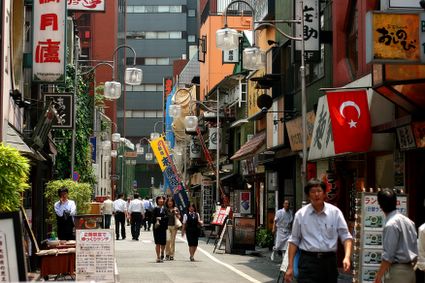
The salaryman charge is about to begin.
Nearby was some sort of ticket agent or something.

It must be dark in there.
It got to be around lunch time, so I started walking back to the station. I stopped in a Starbucks for a drink and a rest (before you judge, I have determined that in Tokyo, Starbucks may be the best place to sit down, cool off, change lenses, review pictures, and plan the next move - there aren't many open coffee shops with a view of the street here, and I really liked sitting in the window watching the people go by.) Once business there was complete, I headed back to the station - either the city was just waking up, or I had my eyes closed in the morning. I saw all kinds of life I hadn't noticed the first time around.
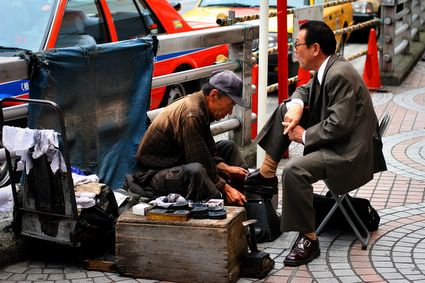

In a back alley - this is the kind of thing I love about Japan.

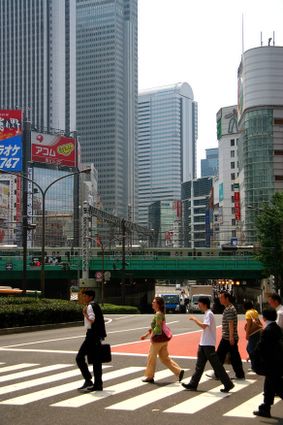
I just realized this is exactly the same place as the first picture, just about four hours later.

The endless rows of amazing Japanese cell phones.
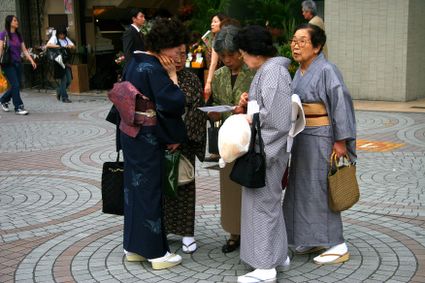
In front of the station - it was like these ladies got lost when they stepped out of their time machine.
I got lunch, and decided there was something I had to do. Tokyo - actually all of Japan - is littered with Pachinko parlors. They make a phenomenal amount of noise, attract compulsive gamblers and organized criminals, and are a pervasive part of Japanese culture. Mori had told me that Pachinko was no good and I shouldn't bother trying it, but here I was, done with lunch and not much planned - so I picked the biggest, loudest Pachinko parlor I could find, and went in. By shouting directly in someone's ear, I established that I had never played before and how do you do it? A nervous looking guy found me a machine ("It's a new machine!" he shouted into my ear in Japanese) and showed me how to feed 1000 yen bills directly into the machine.
I fed my bill in, and a pile of tiny chrome balls the size of peas came out. Turning a knob, you shoot the balls into an elaborate contraption of pins and bouncers, with the ultimate goal being to get your balls into a little hole in the center of the machine. Every time you do this, a video slot machine spins in the middle of the machine, and that's it. If you get three in a row, you go into another mini-game, where the point is (surprise) to get balls into the same little hole. While you're in the mini-game, each ball you get in nets you a lot of new ones. The new ones come out into a lower tray that you periodically empty into a removable tray below your machine. I was sitting between to pros who showed me what to do or reminded me to dump out the balls I was winning when my thing was full. I played for half an hour on my first 1000 yen (about 9 dollars). I filled three trays, having to push a button on the machine to call an assistant to put the full one behind me and give me a new empty. After that half an hour my ears were ringing, my eyes were watering from all the cigarette smoke, and I decided that that was quite enough pachinko. I had no idea how I had done, I figured I had maybe made 20 bucks or something. I changed my (almost 5,000!) balls for special computer coded chips which I then had to take to another place to change for money. When I handed these clear blocks of plastic to the bored looking lady in a booth, I watched her count them off, and then count off some bills - to my great surprise she counted off almost 20,000 yen - like 200 bucks! I was somewhat flabbergasted by this, as I had never played pachinko before and I certainly didn't expect to walk out with a day's spending money handed to me by a lady in a booth.
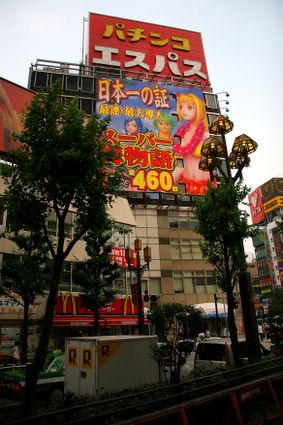
Sea Adventure - my pachinko game.
After that, winnings in hand, I decided to partake in more electronic entertainment in Shinjuku, and that meant arcades. I went from one to the next, trying to find the best one, playing a little in each.
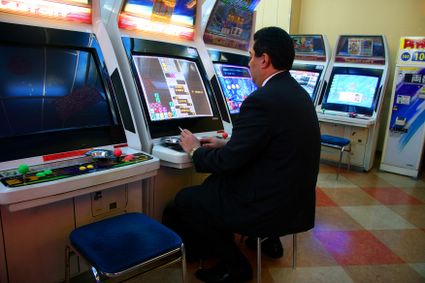
At one, salarymen played Tetris and other similar games during their lunch hour.

This is one of my favorite things about Japan. The arcades are not focused - like what few arcades remain in the States - on taking your money and throwing you out as soon as possible. Here is a combination strategy/card/arcade game. You make a team of soccer players from collectible cards, trying to maximize strengths, and then you lay them on this table. The table reads the cards and brings the players, your stats, and the other players involved in the current tournament up on your screen. You then take all the time you want picking strategies, selecting who will do what, and then you join in. A full tournament takes place between everyone playing, with coaching information on the small screens, and the game "broadcast" on double high-definition displays in front. As things change or players get injured, you will see players frantically switching out players, moving them on the field, calling time outs in order to look for their star rookie in their pile of cards. Tournaments last a long time, probably hours, and there are comfortable benches, drinks and snacks, and ashtrays so you don't ever have to get up. After the match is over, your results are written onto a special card which is dispensed for you, so that next time you can continue with the same record. There are other games like this too - feudal Japanese war strategy, Gundam (in the background), and a horse racing game where each player has a single card containing the horse they have raised and trained to race.
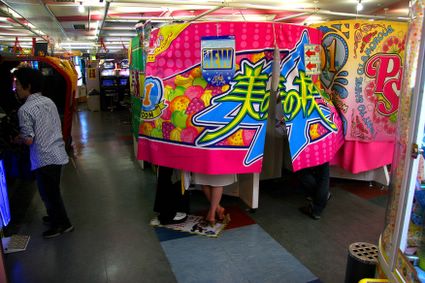
Photo booths - usually for ladies only.
After that, I wanted to check my e-mail, and I made another wonderful discovery - they call them Media Immersion Pods here, but that name sounds fancier than it is. These are places that you can go for a media fix. The sign says internet cafe, but it's more than that. For 300 yen an hour, you get a cubicle with just enough room for a computer, a flatscreen TV, a Playstation 2, and a big reclining chair. At the front are rows of DVDs, huge libraries of Manga, video games, and magazines. You grab whatever you want before heading to your booth, where you can lock yourself in and just melt your brain in total privacy and isolation. Certainly, lots of people use these for sketchy purposes, but I loved it - sitting in this dark cocoon, the sound of people walking to get new movies or manga the only sound, writing e-mails and watching Japanese TV while I guiltlessly and anonymously vegged out.
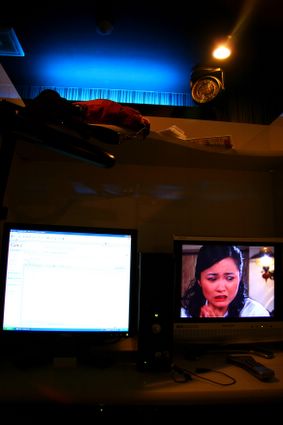
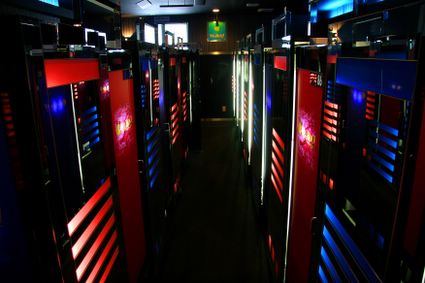
The third floor of booths.
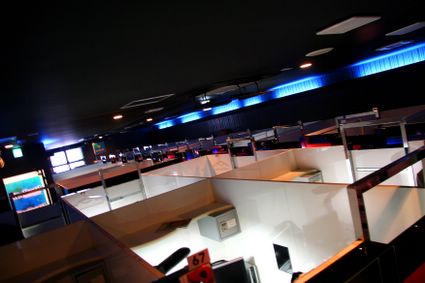
The second floor.
By the mid-afternoon, I was still at around a 100 dollar profit for the day, and I decided to move on.
Shibuya
Shibuya is the biggest of the times-square style intersections in Tokyo - it's the one in Lost in Translation, and it is a great place to watch people, if only because there are so phenomenally many there, at any time of day. For example.
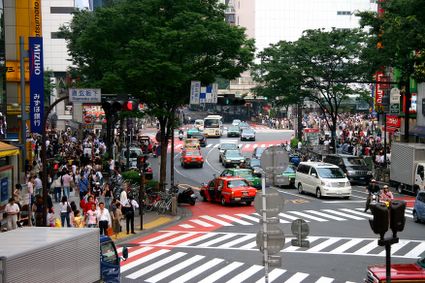
Looking towards the main intersection, while the lights say "Don't cross."

20 seconds later. How insane is that?
I watched that a few times, and then headed into Shibuya's (surprisingly sketchy) back streets.

What I love about this sign is that at some point someone had to come out and put tape over the "drugs" at the bottom. Also, that sign on the right says "We do gift wrapping!"
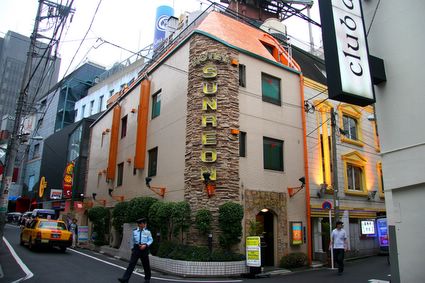
Love Hotel Hill - I have neither the time nor the energy to get into love hotels now - in two sentences: In modern day Japan, children usually stay with their parents and family through marriage, and thus young people have little time alone and less privacy. Love hotels are a the Japanese answer - stay by the hour, check in and out anonymously by vending machine, pick an insanely themed room (medieval castle, hospital room, prison, classroom, and there are normal ones too) buy your sex toys or porn from the vending machine in the room, and have fun.

3 hours rest - 4,000 yen (38 dollars).
I headed back to the main intersection as it got later, where I sat and watched the people ebb and flow for a while.
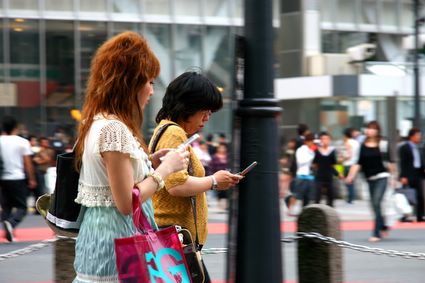
That is excellent hair.
And these are excellent shoes:
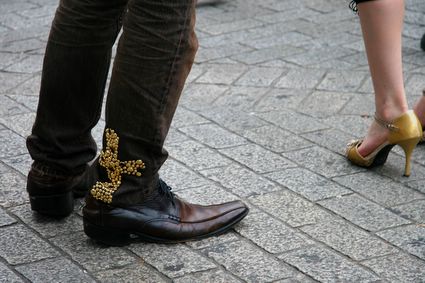
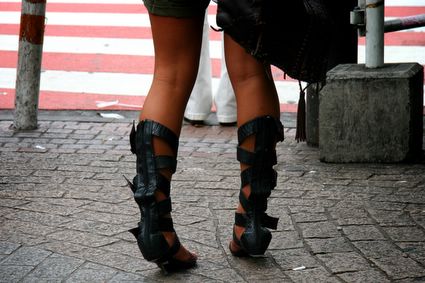
A couple other shots.

Karaoke - suspiciously absent from my stay in Tokyo.
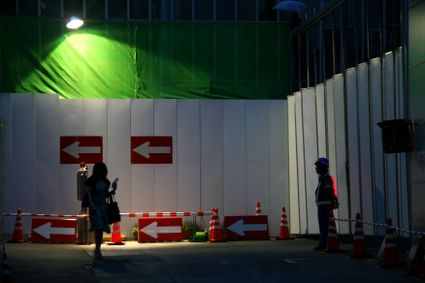
The Ghibli Museum
This is getting a bit long, I appreciate it if you've read this far. This is the last part.
I had heard some good things about the Studio Ghibli museum in Tokyo. Studio Ghibli is the anime studio headed by Miyazaki Hayao, they did Princess Mononoke, Spirited Away, and Howl's Moving Castle, as well as a huge amount of other equally wonderful movies. Out in the suburbs of Tokyo, they have a big museum - it sells out months in advance, and so I had bought a ticket online in May. A long subway ride later, and I was there.
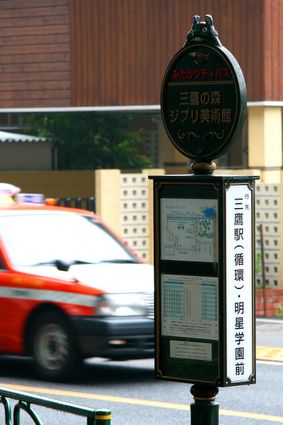
The bus stand, with a Miyazaki creature on top - no mistaking where you are going.
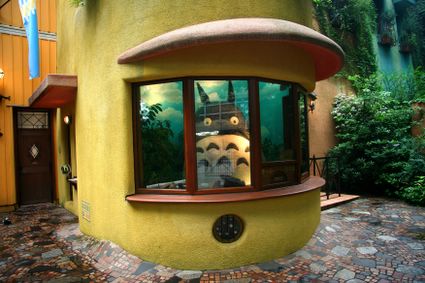
Totoro, greeting guests.
It was so wonderful! It was to Disneyland what Miyazaki's movies are to Disney cartoons. The whole thing was built in a big wild park, looking like some giant creature half-buried in the ground. The outside was full of round stained glass windows (real stained glass, depicting scenes from the movies), lots of climbing plants, patios, walkways, verandas, and little gardens. Inside it was like being in a Miyazaki movie set, if those sets actually existed. Beautiful woodwork and old looking multi-pane windows were all over, the floors were a mix of hardwoods and terra cotta tiles, worn with use. There were great long curving staircases going up, with long brass handrails, but if you wanted there were also tiny winding spiral staircases, sized for children, curving all around. The museum had no set route, they wanted you to find your own way through the building. Each room was special, a dim gallery celebrating everything about animation and projecting movies a projection booth made from a train engine, a series of picture frames that were scenes from Miyazaki's movies, painted on probably 20 layers of glass, just like they do the backgrounds in the movies. To peek into these frames and see a moment from Totoro, with Totoro just hidden behind a mass of branches and leaves, the characters standing in the foreground, and a deep landscape in the background was really wonderful, like seeing the movies come to life.

The outside - pictures were entirely forbidden indoors.
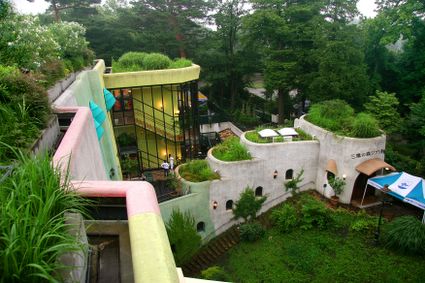
In the roof garden.
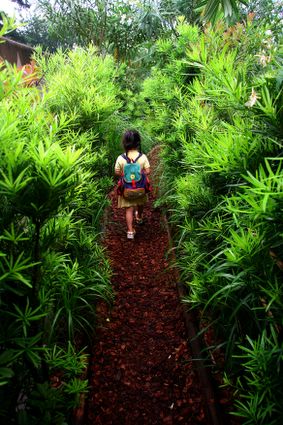
Beautiful gardens, perfectly tended, with winding paths perfect for exploring if you're seven years old.
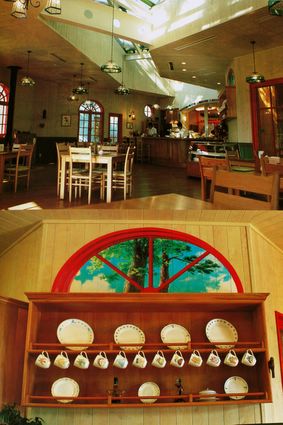
Again, not my picture. Two shots of the restaurant from the catalog.
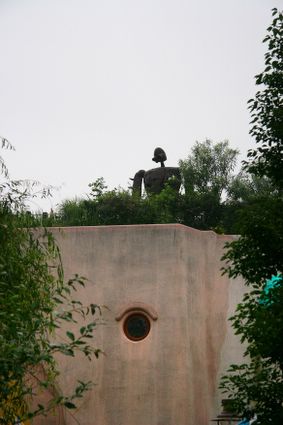
Leaving the museum.
And that's it, I'm spent and if you've read this far, so are you. See you Wednesday for what will hopefully be a lighter entry.
Shinjuku

I'm standing in the cool half of Shinjuku. Across the tracks is the lame half.
Being the beating heart - Shinjuku is full of business, and so during the week the streets are pretty quiet, and teeming with salarymen in the morning, at lunch, and at night. I had spent a lot of time in the center strip of Shinjuku, so I decided to venture out and get a feel for the neighborhood. At first, the impression was so-so. A lot of Shinjuku off the main roads looks like Downtown Manhattan behind the financial district - cold office buildings, a few businesspeople on the street, not much life, not much color. I kept walking around, and eventually found some smaller streets, restaurants of all types getting ready for the lunch rush.

The salaryman charge is about to begin.
Nearby was some sort of ticket agent or something.

It must be dark in there.
It got to be around lunch time, so I started walking back to the station. I stopped in a Starbucks for a drink and a rest (before you judge, I have determined that in Tokyo, Starbucks may be the best place to sit down, cool off, change lenses, review pictures, and plan the next move - there aren't many open coffee shops with a view of the street here, and I really liked sitting in the window watching the people go by.) Once business there was complete, I headed back to the station - either the city was just waking up, or I had my eyes closed in the morning. I saw all kinds of life I hadn't noticed the first time around.


In a back alley - this is the kind of thing I love about Japan.


I just realized this is exactly the same place as the first picture, just about four hours later.

The endless rows of amazing Japanese cell phones.

In front of the station - it was like these ladies got lost when they stepped out of their time machine.
I got lunch, and decided there was something I had to do. Tokyo - actually all of Japan - is littered with Pachinko parlors. They make a phenomenal amount of noise, attract compulsive gamblers and organized criminals, and are a pervasive part of Japanese culture. Mori had told me that Pachinko was no good and I shouldn't bother trying it, but here I was, done with lunch and not much planned - so I picked the biggest, loudest Pachinko parlor I could find, and went in. By shouting directly in someone's ear, I established that I had never played before and how do you do it? A nervous looking guy found me a machine ("It's a new machine!" he shouted into my ear in Japanese) and showed me how to feed 1000 yen bills directly into the machine.
I fed my bill in, and a pile of tiny chrome balls the size of peas came out. Turning a knob, you shoot the balls into an elaborate contraption of pins and bouncers, with the ultimate goal being to get your balls into a little hole in the center of the machine. Every time you do this, a video slot machine spins in the middle of the machine, and that's it. If you get three in a row, you go into another mini-game, where the point is (surprise) to get balls into the same little hole. While you're in the mini-game, each ball you get in nets you a lot of new ones. The new ones come out into a lower tray that you periodically empty into a removable tray below your machine. I was sitting between to pros who showed me what to do or reminded me to dump out the balls I was winning when my thing was full. I played for half an hour on my first 1000 yen (about 9 dollars). I filled three trays, having to push a button on the machine to call an assistant to put the full one behind me and give me a new empty. After that half an hour my ears were ringing, my eyes were watering from all the cigarette smoke, and I decided that that was quite enough pachinko. I had no idea how I had done, I figured I had maybe made 20 bucks or something. I changed my (almost 5,000!) balls for special computer coded chips which I then had to take to another place to change for money. When I handed these clear blocks of plastic to the bored looking lady in a booth, I watched her count them off, and then count off some bills - to my great surprise she counted off almost 20,000 yen - like 200 bucks! I was somewhat flabbergasted by this, as I had never played pachinko before and I certainly didn't expect to walk out with a day's spending money handed to me by a lady in a booth.

Sea Adventure - my pachinko game.
After that, winnings in hand, I decided to partake in more electronic entertainment in Shinjuku, and that meant arcades. I went from one to the next, trying to find the best one, playing a little in each.

At one, salarymen played Tetris and other similar games during their lunch hour.

This is one of my favorite things about Japan. The arcades are not focused - like what few arcades remain in the States - on taking your money and throwing you out as soon as possible. Here is a combination strategy/card/arcade game. You make a team of soccer players from collectible cards, trying to maximize strengths, and then you lay them on this table. The table reads the cards and brings the players, your stats, and the other players involved in the current tournament up on your screen. You then take all the time you want picking strategies, selecting who will do what, and then you join in. A full tournament takes place between everyone playing, with coaching information on the small screens, and the game "broadcast" on double high-definition displays in front. As things change or players get injured, you will see players frantically switching out players, moving them on the field, calling time outs in order to look for their star rookie in their pile of cards. Tournaments last a long time, probably hours, and there are comfortable benches, drinks and snacks, and ashtrays so you don't ever have to get up. After the match is over, your results are written onto a special card which is dispensed for you, so that next time you can continue with the same record. There are other games like this too - feudal Japanese war strategy, Gundam (in the background), and a horse racing game where each player has a single card containing the horse they have raised and trained to race.

Photo booths - usually for ladies only.
After that, I wanted to check my e-mail, and I made another wonderful discovery - they call them Media Immersion Pods here, but that name sounds fancier than it is. These are places that you can go for a media fix. The sign says internet cafe, but it's more than that. For 300 yen an hour, you get a cubicle with just enough room for a computer, a flatscreen TV, a Playstation 2, and a big reclining chair. At the front are rows of DVDs, huge libraries of Manga, video games, and magazines. You grab whatever you want before heading to your booth, where you can lock yourself in and just melt your brain in total privacy and isolation. Certainly, lots of people use these for sketchy purposes, but I loved it - sitting in this dark cocoon, the sound of people walking to get new movies or manga the only sound, writing e-mails and watching Japanese TV while I guiltlessly and anonymously vegged out.


The third floor of booths.

The second floor.
By the mid-afternoon, I was still at around a 100 dollar profit for the day, and I decided to move on.
Shibuya
Shibuya is the biggest of the times-square style intersections in Tokyo - it's the one in Lost in Translation, and it is a great place to watch people, if only because there are so phenomenally many there, at any time of day. For example.

Looking towards the main intersection, while the lights say "Don't cross."

20 seconds later. How insane is that?
I watched that a few times, and then headed into Shibuya's (surprisingly sketchy) back streets.

What I love about this sign is that at some point someone had to come out and put tape over the "drugs" at the bottom. Also, that sign on the right says "We do gift wrapping!"

Love Hotel Hill - I have neither the time nor the energy to get into love hotels now - in two sentences: In modern day Japan, children usually stay with their parents and family through marriage, and thus young people have little time alone and less privacy. Love hotels are a the Japanese answer - stay by the hour, check in and out anonymously by vending machine, pick an insanely themed room (medieval castle, hospital room, prison, classroom, and there are normal ones too) buy your sex toys or porn from the vending machine in the room, and have fun.

3 hours rest - 4,000 yen (38 dollars).
I headed back to the main intersection as it got later, where I sat and watched the people ebb and flow for a while.

That is excellent hair.
And these are excellent shoes:


A couple other shots.

Karaoke - suspiciously absent from my stay in Tokyo.

The Ghibli Museum
This is getting a bit long, I appreciate it if you've read this far. This is the last part.
I had heard some good things about the Studio Ghibli museum in Tokyo. Studio Ghibli is the anime studio headed by Miyazaki Hayao, they did Princess Mononoke, Spirited Away, and Howl's Moving Castle, as well as a huge amount of other equally wonderful movies. Out in the suburbs of Tokyo, they have a big museum - it sells out months in advance, and so I had bought a ticket online in May. A long subway ride later, and I was there.

The bus stand, with a Miyazaki creature on top - no mistaking where you are going.

Totoro, greeting guests.
It was so wonderful! It was to Disneyland what Miyazaki's movies are to Disney cartoons. The whole thing was built in a big wild park, looking like some giant creature half-buried in the ground. The outside was full of round stained glass windows (real stained glass, depicting scenes from the movies), lots of climbing plants, patios, walkways, verandas, and little gardens. Inside it was like being in a Miyazaki movie set, if those sets actually existed. Beautiful woodwork and old looking multi-pane windows were all over, the floors were a mix of hardwoods and terra cotta tiles, worn with use. There were great long curving staircases going up, with long brass handrails, but if you wanted there were also tiny winding spiral staircases, sized for children, curving all around. The museum had no set route, they wanted you to find your own way through the building. Each room was special, a dim gallery celebrating everything about animation and projecting movies a projection booth made from a train engine, a series of picture frames that were scenes from Miyazaki's movies, painted on probably 20 layers of glass, just like they do the backgrounds in the movies. To peek into these frames and see a moment from Totoro, with Totoro just hidden behind a mass of branches and leaves, the characters standing in the foreground, and a deep landscape in the background was really wonderful, like seeing the movies come to life.

The outside - pictures were entirely forbidden indoors.

In the roof garden.

Beautiful gardens, perfectly tended, with winding paths perfect for exploring if you're seven years old.
The best part of the museum proper was on the second floor. The when I was at the museum, I thought it was a recreation of Studio Ghibli, but reading the catalog I bought, I learned it was something more - an animation studio squeezed into a fictional English mansion, worked by characters invented by Miyazaki. Each station was a step from the actual creation of a Ghibli film, but the aesthetic and sensibility was straight out of the movies. Everything was worn cushions, beautiful, messy chaos, and a painstaking attention to detail. The stuff that populated these fantasy rooms was all real, and perfectly illustrated the process of these artists.
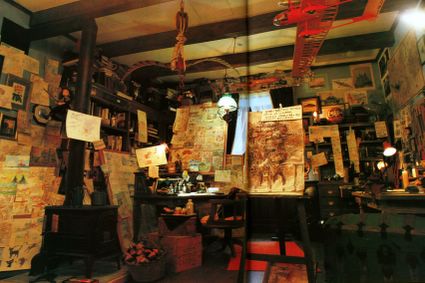
This isn't my picture, It's from the catalog. One of the studio rooms.
A desk had a pile of ancient cassette tapes, a broken down boom box teetering on a stack of old books, and a big bowl completely full of cigarette butts. Every sketch on the wall, every half finished or finished painting or animation cell was the real deal. There was a stack of papers on one of the desks, and I leafed through them and each one was an original (or maybe a copy, I don't know) gouache background from Spirited Away. A shot of the suburban streets of Japan, a misty lake, a field with a clear blue sky - each one painted beautifully and marked with what scene and shot it was for. One room practically took my breath away, on three walls, floor to ceiling, were little gouache and pencil sketches of all kinds of things from all of his movies. Airplanes, animals, characters, places, the biggest one was maybe a foot square. They were all pinned on the wall, covering some old airplane posters and were covered in notes. A room filled with bookshelves had copies of every single storyboard from every single movie that Ghibli has done, thick books that you could leaf through while sitting at an old wooden table. Framed on the walls were original Miyazaki paintings and cells, moments that he had picked and saved to decorate his work spaces. He had giant binders, maybe seven or eight of them, that were inspiration books. Each page, maybe 24x12" was covered in 4x6 photos that Miyazaki took while traveling. There were pictures of all over Japan, of Kyoto in fall, Tokyo in spring, the countryside, travels in Germany, England, the South Pacific, from small airplanes, scuba diving - thousands of pictures, all taken with what looked like a cheap point and shoot, but each one of a scene or detail that grabbed his interest for some reason. It was really amazing, being in these rooms, surrounded by one of the most lively creative processes I have ever seen, and being able to leaf through these inspiration books.

On the roof - a full-size robot from Laputa: Castle in the Sky.

This isn't my picture, It's from the catalog. One of the studio rooms.
A desk had a pile of ancient cassette tapes, a broken down boom box teetering on a stack of old books, and a big bowl completely full of cigarette butts. Every sketch on the wall, every half finished or finished painting or animation cell was the real deal. There was a stack of papers on one of the desks, and I leafed through them and each one was an original (or maybe a copy, I don't know) gouache background from Spirited Away. A shot of the suburban streets of Japan, a misty lake, a field with a clear blue sky - each one painted beautifully and marked with what scene and shot it was for. One room practically took my breath away, on three walls, floor to ceiling, were little gouache and pencil sketches of all kinds of things from all of his movies. Airplanes, animals, characters, places, the biggest one was maybe a foot square. They were all pinned on the wall, covering some old airplane posters and were covered in notes. A room filled with bookshelves had copies of every single storyboard from every single movie that Ghibli has done, thick books that you could leaf through while sitting at an old wooden table. Framed on the walls were original Miyazaki paintings and cells, moments that he had picked and saved to decorate his work spaces. He had giant binders, maybe seven or eight of them, that were inspiration books. Each page, maybe 24x12" was covered in 4x6 photos that Miyazaki took while traveling. There were pictures of all over Japan, of Kyoto in fall, Tokyo in spring, the countryside, travels in Germany, England, the South Pacific, from small airplanes, scuba diving - thousands of pictures, all taken with what looked like a cheap point and shoot, but each one of a scene or detail that grabbed his interest for some reason. It was really amazing, being in these rooms, surrounded by one of the most lively creative processes I have ever seen, and being able to leaf through these inspiration books.

On the roof - a full-size robot from Laputa: Castle in the Sky.
I guess what was really amazing about this is that it was a kid's museum in every way, but the fidelity and completeness of every bit of every exhibit went beyond anything I had ever seen before. I was in the storyboard room, and as a piece of scenery, there was a little bookshelf. The middle shelves had sculptures of airplanes from Porco Rosso on them, but the top shelf had four old-looking books. I pulled one out, and it was a real old American book, with someone's name and "1939" written on the inside cover. I went back into the other room, and every single book in the enormous pile next to the storyboard desk was real. The giant jar of used pencils all really were used up pencils, with the ends smudged dark from dirty hands. The studios were fictitious, but I would bet that the materials that made them up were all from the real Studio Ghibli.
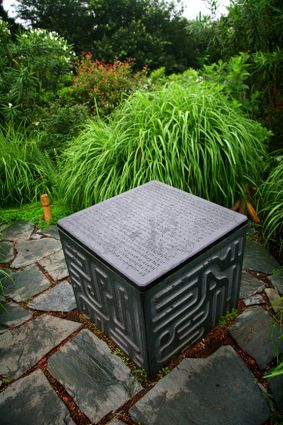
I don't know what anime this is from, but it was cool.
The shops, the galleries, the movie theater where you see an original short that you can't see anywhere else - every detail, every corner - was perfect. There was no cheap plaster to imitate stone, no phony wood anywhere. The railings were all beautiful cast-iron that reminded me of Cobble Hill front yards. Everything was real, as if Miyazaki himself decided to turn his drawings and ideas into a real thing. I think that's probably not very far from the truth, but it was really a great feeling, being in a place that - when you touch the walls or crouch down to go through a tiny doorway from The Cat Returns - doesn't feel like a big lie that is designed to fool children.

I don't know what anime this is from, but it was cool.
The shops, the galleries, the movie theater where you see an original short that you can't see anywhere else - every detail, every corner - was perfect. There was no cheap plaster to imitate stone, no phony wood anywhere. The railings were all beautiful cast-iron that reminded me of Cobble Hill front yards. Everything was real, as if Miyazaki himself decided to turn his drawings and ideas into a real thing. I think that's probably not very far from the truth, but it was really a great feeling, being in a place that - when you touch the walls or crouch down to go through a tiny doorway from The Cat Returns - doesn't feel like a big lie that is designed to fool children.
So that was all wonderful, but I actually got the best thing last. The museum has a cafe, the Straw Hat Cafe, and I figured it would be an overpriced and mediocre museum cafe, but I was hungry and far from central Tokyo, and it was lunchtime. I went up, and got on line, and after a half-hour wait, I was seated at the counter. The first sign that things were going well was the drink menu. The first and second items on the menu were "Looking up at a Clear Blue Sky in the Field Cream Soda" and "Sunset Cream Soda." Obviously, I ordered the first. First of all, the prices were significantly lower than what you might expect to pay in a mid-range restaurant in Tokyo. Second of all, everything was organic, fresh, and the straws were real straws, as in nice pieces of straw from a field.

Again, not my picture. Two shots of the restaurant from the catalog.
The restaurant, like the museum, spared no expense in capturing the feel of the movies. Most Miyazaki movies have some scene of a busy kitchen or workshop operated mostly by women, and it was as if those scenes had been inspired by this restaurant. Dozens of women and a few men worked in a completely visible kitchen, each with a soft-looking white shirt, sort of reddish-orange apron, and a matching cloth tied in their hair. It's difficult to describe, but if you've seen the look in any of his movies, you know what I'm talking about. Again, every detail was perfect - a man drew a straw hat in chocolate on the foam of every hot chocolate, the kettles were all giant and made of painted metal in deep yellows and reds, when they had to make iced tea, they put a block of ice about 8 inches square in a pot, and poured a boiling kettle of tea over it. Ice cubes didn't come out of a freezer, but were broken off a beautiful clear block of ice with a pick. When my drink came, it was a light blue cream soda with a perfect sphere of homemade vanilla ice cream floating on top of it, held up by two big chunks of ice. I had a delicious pork sandwich and then sat and watched it all go on around me for a while.

Leaving the museum.
And that's it, I'm spent and if you've read this far, so are you. See you Wednesday for what will hopefully be a lighter entry.
posted byHi,
Interesting account of your Jap trip. May I ask how did you managed to book Ghibli ticket online? You have to know japanese right? I soooooooo want to go but *headache* over how to get tickets :(
posted by
If you are living in Japan, get someone to help you with the online form, and then picking up the tickets at Lawson's is really easy as long as you know your adress, phone number, and reservation number. If you live elsewhere, there are english links on the ghibli site.
» Post a Comment